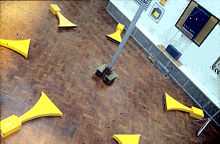John Wood (design theorist)
John Wood, DipAD, ADF(Manc), FRSA (b. 25 August 1045) is Emeritus Professor of Design[1] at Goldsmiths College, University of London.[2] In Professor Geoffrey Crossick's introduction to Wood's inaugural lecture at Goldsmiths, University of London on 21 October 2008, he said that Wood has had "a transforming influence on design theory and practice."[3] He taught many Young British Artists when he was Deputy Head of the Fine Art Department at Goldsmiths between 1978 and 1988. He has received AHRC and EPSRC funding for research into metadesign.
Biography


Born in Bath Wood attended Harrow County School for Boys, and then studied Fine Art at Manchester School of Art. His final year degree show (1968) consisted of electronic sound installations that were influenced by the physical presence of visitors. Examples of his early works include: 'King of Shouting House' (1969) - a computer assisted play, for the ICA;[4] 'Tune Doodler' (1972) - mass-produced electronic sculpture commissioned by Jasia Reichardt.[5] He also created "solar energy artworks" - 'Black Box' - control circuit regulated a practical solar roof at Eithen-y-Gaeir, North Wales (1974)[6] and Sunsharer' window maximized solar energy for domestic use without compromising plant needs (1975).[7]
Wood is an original member of the rock band Deaf School where he performs as Max Ripple, he was also an original member of the Kreutzer Quintet.
His published works include: Designing for Micro-utopias (2007); thinking beyond the possible, Ashgate, UK, ISBN 0-7546-4608-4 and The Virtual Embodied; presence, practice, technology (1998), (Ed.), Routledge, London and New York, ISBN 0-415-16025-1 (hardback), ISBN 0-415-16026-X (paperback).
See also
Metadesigners Open Network http://metadesigners.org/tiki/tiki-index.php
Attainable Utopias http://attainable-utopias.org/tiki/tiki-index.php
References
- ↑ http://www.gold.ac.uk/design/
- ↑ Goldsmiths Bio page
- ↑ http://blip.tv/file/1712708
- ↑ Punt, M., (2008), 'Play Orbit: a play on the history of play', Technoetic Arts: a Journal of Speculative Research, Print ISSN: 1477-965X, Volume 6, Issue 2, August 2008, p. 135-148
- ↑ Reichardt, J., 'Twenty Years of Symbiosis between Art & Science', Impact of Science on Society, 24, 1, 41-51, Jan/Mar 74.
- ↑ Brachi, P., (1974) "Sun on the Roof", New Scientist, 19 September 1974
- ↑ TV programme - "A House for the Future" introduced by Brian Truman, broadcast July 1974 (Granada Television)
|